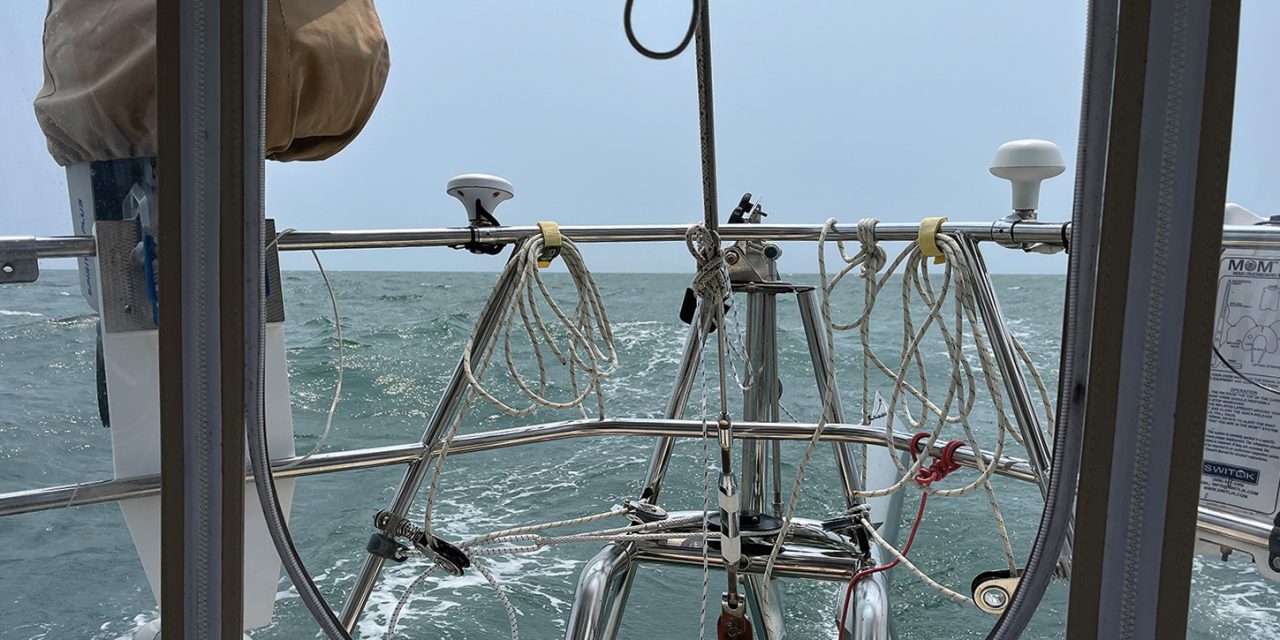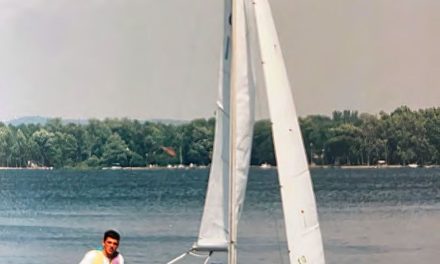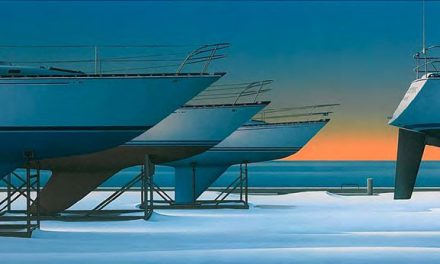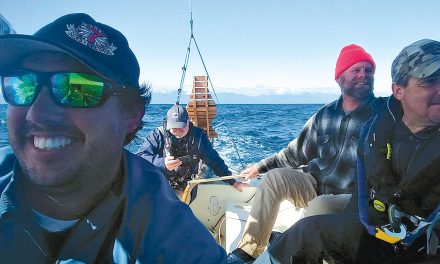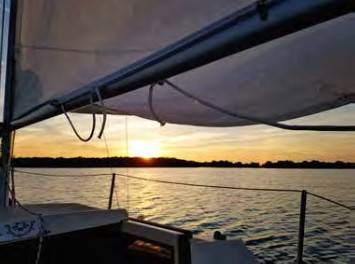A series of bad decisions leads to a potentially fatal situation
Issue 154: Jan/Feb 2024
Squalls were building rapidly as Jo Beth rumbled along under engine power, some 10 miles southeast of the entrance channel at Cape May Harbor on New Jersey’s southern coast. Winds blew from the south-southwest at 25 to 28 knots, with a few lulls around 22 knots. The waves were short and choppy, around 3 feet, with an occasional 5-footer slamming our hull. Jo Beth, our 1984 Pacific Seacraft Crealock 34, rolled and yawed a bit, but we were doing fine, warm and reasonably comfortable in the cockpit enclosure.
The forecast was pretty much as stated; the only thing off was the timing of the squalls and thunderstorms. They were not predicted to be in our area until much later in the day, around 5 or 6 p.m., but they were on us now, at noon. The forecast had also warned that some of the thunder- storms could produce winds of 50, 60, or even 70 knots — close to hurricane force — and it was this piece of information that concerned us the most.
The squalls would be upon us before we could reach the harbor. Winds in squalls can change direction rapidly, and we didn’t want to have any sail out in those conditions. Lisa and I had dropped sails and secured Jo Beth as best we could, ready for the inevitable hit that was coming. But I was not happy with the way the mainsail had flaked when it dropped into the stackpack, and that the mainsail cover was not closed and secured. I was worried a strong gust could catch the sail and pull it out of the cover, potentially damaging the sail or rigging.
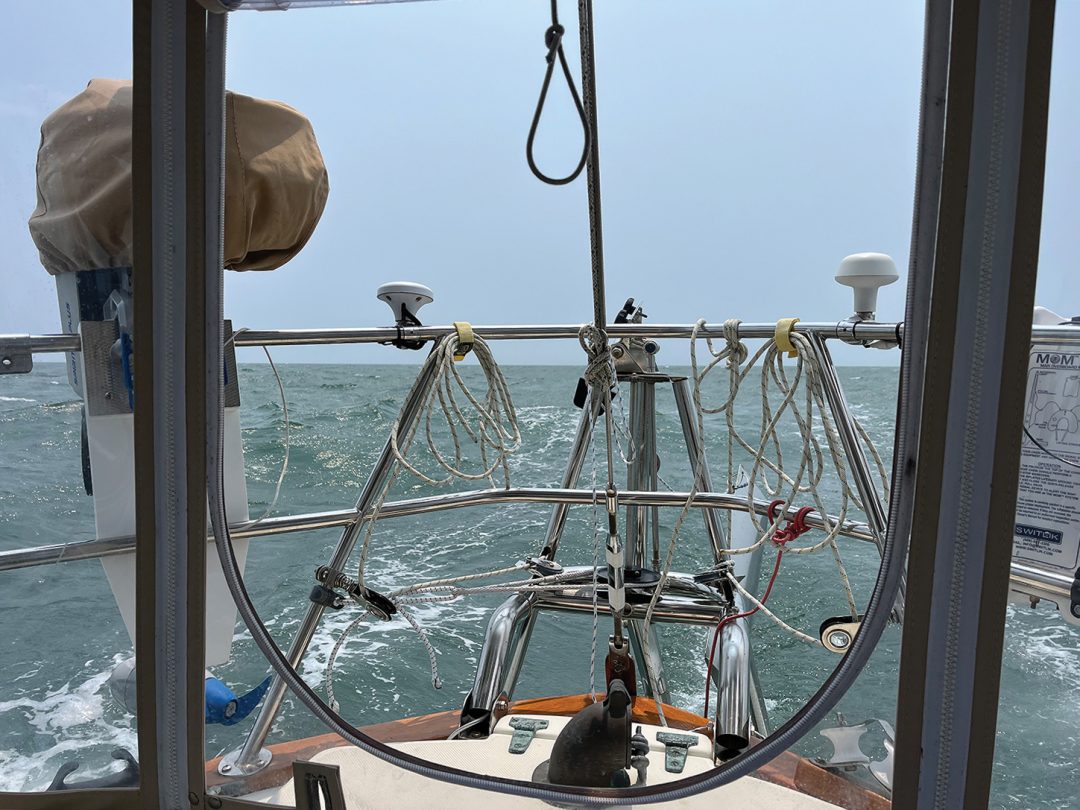
The solution was simple: retrieve my safety harness from the cabin and clip onto the jackline. Then I would stand on the cockpit coaming, and while holding on with one hand, reach and grab the sail cover zipper pull with the other and zip the cover closed. It’s something I’d done many times with the boat underway, at anchor, and secured to a dock. It seemed like no big deal.
Lisa disagreed. She felt the sail was secured well enough, and if the wind did catch it, we’d deal with it accordingly. I argued that an ounce of prevention was always better than a pound of cure. After putting on my PFD and clipping my harness onto the jackline, I went onto the starboard side deck and stepped onto the coaming.
The boom was sheeted in tight but still swung from side to side with the motion of the boat. I had a solid handhold on the grabrail on the side of the dodger and leaned over the frame of the cockpit enclosure, reaching for the zipper pull with my left hand. The zipper pulled easily, and I realized its ends had separated.
I only need a second, I thought. I let go of the handhold and leaned farther over the enclosure, my upper chest resting on the boom, and reached for the cover, grabbing both sides and pulling them together. Then, in a split second, I was weightless, holding nothing.
At the very moment I let go of the handrail, one of those 5-foot waves pushed under the boat. Jo Beth rolled to port, and then snapped back to star- board. The swing of the boom came back into my upper chest and flung me backward into the air. I was unaware of what happened until I was fully submerged in the Atlantic Ocean. I didn’t even have time to blink; I stared into a green-blue mix of bubbles and water. There was no panic. If anything, there was disbelief, which was quickly cleared away.
Our harnesses have a double tether system; one is a no-stretch tether that measures a little more than 3 feet, and the other is a stretchy tether that is around 6 and a half feet when fully stretched. When I clipped my harness to the jackline on the deck, I used the stretchy tether. Jo Beth was still moving through the water under motor power at 5.5 or 6 knots. The tether pulled taut with a jerk, yanking me forward and slamming me chest first into the bottom of the boat. The pressure of Jo Beth’s bow wave pinned me against the hull while pushing me toward the surface. The wind was coming over the port side and the boat was heeling to starboard, placing the caprail a bit lower than if she were floating fully upright.
Still facing forward, I was able to reach up and grab the caprail, pulling my head from the water, then was promptly hit in the face by two waves, swallowing mouthfuls of ocean. I spun myself around so my back was to the bow and looked up into Lisa’s stone- faced expression, her eyes wide with shock.
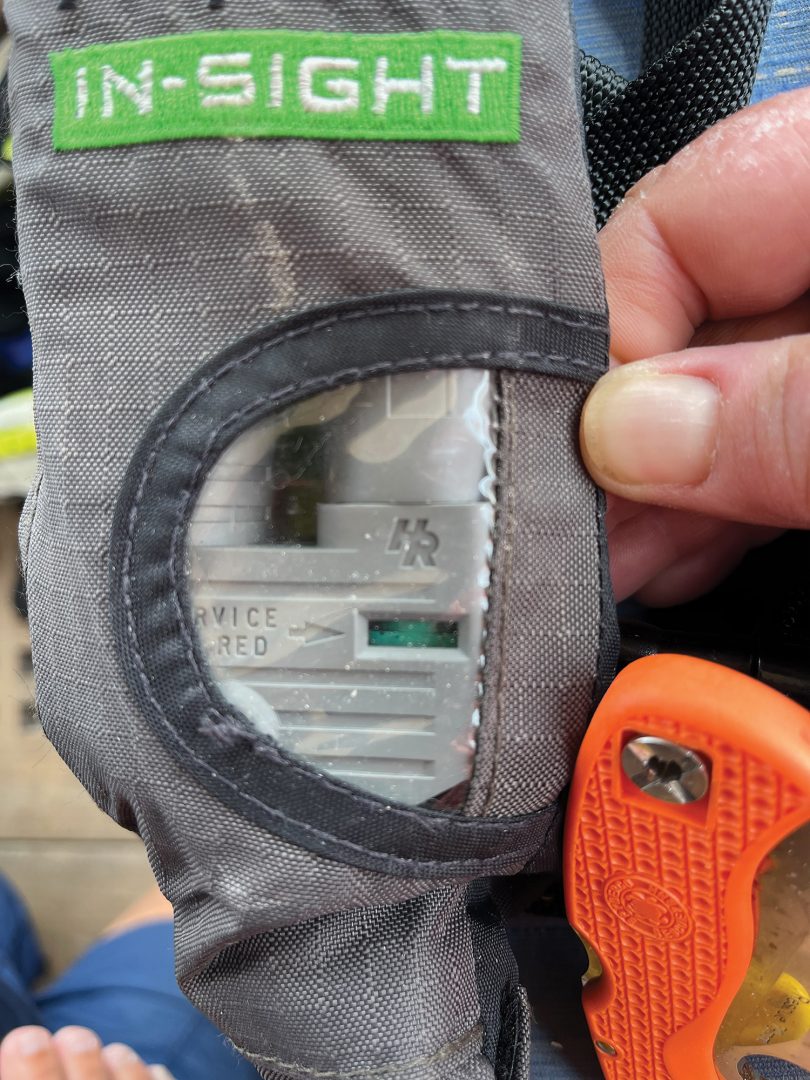
The vest the author was wearing when he went overboard shows the inflator mechanism armed and ready, post submersion.
I realized then that my automatic-inflating PFD had not deployed. I had been in the water for perhaps 30 seconds. The PFD should have inflated within 10 seconds, 15 at most. The vest has a manual inflation activation system as a backup, but I didn’t think of that at the time. My entire focus, and Lisa’s, was getting me back onto the boat.
Lisa had moved to the cockpit and put the motor into neutral. Almost immediately, the incredible pressure of the bow wave eased, but Jo Beth didn’t come to a stop. The strong winds and waves still pushed her along at a knot or two. Lisa slacked and lowered the starboard jib sheet into the water so it formed a dip for me to use as a step to get my chest and shoulders above water.
When my feet were on the sheet, she winched it in as much as she could. I asked her to grab my harness and pull me up so I could get a better hold on the rails by wrapping my arms fully around them. I had tried pulling myself up and swinging my legs to the rails, but couldn’t do it. I’m too short, and the water dragging against my legs and torso eliminated that as a recovery option. Once I had a secure hold with my arms and was standing on the jib sheet, I began to relax a little. Then I realized Lisa was on deck without her vest.
“Get your vest on and clip in,” I told her.
“No,” she answered, “We don’t have time. I’ve got to get the ladder moved to this side.”
Jo Beth’s boarding ladder was fitted on the port side of the boat, but it can be easily moved to either side.
“Get your harness on,” I said more urgently, adding, “If you go in, this is over for both of us.”
She quickly slipped into her vest and clipped on. My grip on the rails was weakening.
“Hurry!” I yelled.
She returned with the ladder, and once it was set and lowered, I found it incredibly difficult to release my grip on the rails. This was partially out of a fear of letting go, but due more to the fact my arms and hands were cramping intensely. Lisa grabbed my harness as I reached for the ladder with my right hand. Together, we pulled me over, and after finding the lower rung with my right foot, I swung the rest of the way and was fully on the ladder. We hadn’t deployed the ladder legs, which would have stood the ladder off from the hull, as I was afraid I couldn’t maintain my hold long enough. The ladder rungs were flat against the hull, which meant only my toes were on them. I found the next rung, and the next, and was then able to reach a handrail of the deckhouse and pull myself back on deck. I was safe.
My mouth, sinuses, and eyes stung with sea water, and my arms and hands were shaking from adrenaline and the exertion of holding onto the boat. Lisa helped me back into the cockpit and zipped the enclosure closed.
“My vest didn’t deploy,” I stammered.
Not a minute later, the full force of the squall hit, with a peak wind of 52 knots — that’s just under 60 miles per hour, comparable to a strong tropical storm. The rain pounded down hard and visibility dropped to mere feet. The waves built into a steep 6-foot chop and were more like moving walls of water than ocean waves. Blinding streaks of lightning flashed and thunder boomed.
Lisa steered us on a course to the east, putting the wind and waves on our stern quarter, and ran off. After about 45 minutes, the rain had abated and winds were down to 10 knots. A heavy, black cloud hung over us, and the horizon to the east was an ugly green-gray, like a bad bruise on the sky. The skies to the west, however, were bright and clearing. As Jo Beth heaved in the swell, the seas settled back to the 3- to 5-foot range and we resumed our course for Cape May Harbor.
“I’m sorry,” I said, after things were calmer.
“Me too,” Lisa said, worry still etched on her face.
“Thank you for getting me back on board,” I told her.
“You got yourself back aboard,” she said.
“We did it together,” I emphasized.
A moment passed and the skies brightened a bit more. The motor purred, an unseen current giving us a boost toward the coast. We opened some of the enclosure panels for fresh air.
“Did I look scared?” I asked Lisa.
“No,” she answered. “You looked pissed off and determined.” I think she sugarcoated her answer.
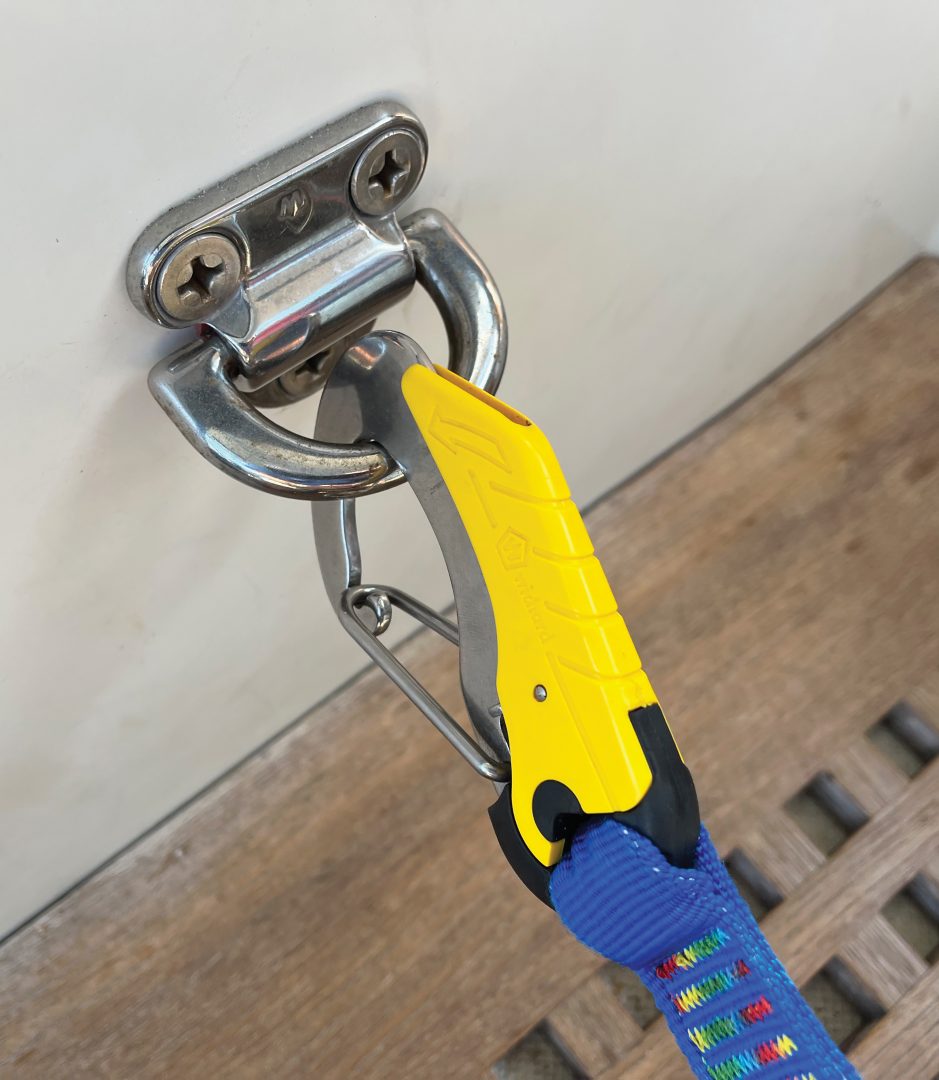
These large cockpit pad-eyes allow the tether to move with the user.
After we anchored in Cape May Harbor, I phoned the company that has serviced and maintained all of the lifesaving and firefighting equipment we carry aboard Jo Beth. They had just serviced our vests three months earlier, and the concern in the owner’s voice was evident as I described what had happened. He asked that we ship the vest back to him for an inspection and testing to figure out what had gone wrong. In the meantime, he arranged for a new vest and harness system to be shipped to me. The company tested my vest; a visual inspection revealed no problems, and it deployed in their water test tank within seven seconds of immersion. Why the vest failed when I was in the ocean remains undetermined.
I’m OK. Lisa’s OK. We’re through this, and for the most part, none the worse for wear. We’re back to our normal routine — boat chores, laundry, cleaning, provisioning, and monitoring weather fore- casts, though with a revised outlook on safety protocols.
Ocean cruising is often said to be hours of boredom punctuated by moments of terror. We couldn’t agree more.
The Takeaway
I spent most of my professional life as a marine surveyor investigating marine insurance claims and quickly learned that accidents are rarely the result of a single event. Almost always, a series of small, seemingly insignificant oversights and mistakes lead to an accident. What happened to me was the culmination of multiple poor decisions on my part. It was not the fault of the weather, or Jo Beth, or the ocean. I made an impulsive decision based on inadequate data, and as Lisa readily points out, I ignored her input on the situation. Plus, I violated the age-old sailor’s rule of, “one hand for the ship, one hand for yourself.” It almost cost me my life.
Even in calm conditions, going overboard at sea can be a death sentence, even if the crew sees you, even in clear weather. If you’re singlehanding, even if a PFD/ harness and tether is used, it likely becomes a body recovery system. A person in the water, being dragged by a boat, can drown in seconds. Going overboard at night, or without being tethered or your crew knowing you’re gone, is most certainly the end. These are facts we sailors accept as part of the risk versus reward equation; this is cruising.
This seems obvious, but it has to be said: The most important lesson learned is, stay aboard the boat. Had our mainsail come unfurled in the squall, we could have dealt with it later. My decision to try to prevent what was an unlikely scenario brought about an infinitely worse set of circumstances. Had I hit my head, broken a bone, dislocated a joint, or become entangled under the boat, the outcome would have been much worse.

Jo Beth rests at anchor off of Bold Island in Maine’s Penobscot Bay, with her swim ladder deployed correctly.
In our post-analysis of the event, I determined that had I been clipped with the short tether, or clipped onto one of the two pad-eyes fitted in the cockpit, I might not have gone in the water, at least not fully. It also occurred to me that if the vest inflated during our recovery process, the force of the inflation may have caused me to lose my grip on the rails. On the other hand, the inflated vest would provide substantial buoyancy, possibly making it easier to get back aboard; it also would have increased the drag I was already battling.
Lisa didn’t radio the Coast Guard or make a Mayday call on the VHF; there simply wasn’t time. I was attached to the boat and conscious, so the utmost priority was getting me back aboard. Had I become separated from the boat, a Mayday call would have been made. Our vests do have ACR ResQLink+ 406 Personal Locator Beacons and Ocean Signal rescueME MOB1 devices with AIS attached, along with knives, whistles, and water-activated lights. But because my vest didn’t inflate, the beacons never activated. They can be activated manually.
At the root of this situation is a lesson as to how complacency had crept into our shipboard routines. In 2022, we added a full cockpit enclosure to Jo Beth. We stayed warm and dry in foggy conditions and rain. We were sheltered from chilly winds and spray. We felt safe and secure, and without much thought, we stopped wearing our harnesses and tethers when offshore. Early on, they were in the cockpit with us, but after a few uneventful passages, they stayed in the cabin. Friends told us of a time when they were motoring under nearly flat calm conditions at night, somewhere off the east coast of Florida. Out of the darkness came two unusually large and breaking waves, destroying their cockpit enclosure. Our cockpit enclosure has been a wonderful thing, but it has fostered a false sense of safety.
Another lesson learned is that neither Lisa nor I is capable of getting ourselves back aboard without the assistance of the other. Lisa struggled to help me while I was in the water, and that was with me doing everything I could to assist. Had I been unable to help myself, things would have gone very differently. To this end, we’re considering adding a second boarding ladder and keeping the running back- stays, each with a six-to-one purchase, deployed to utilize in any recovery process. In this instance, Lisa should have clipped the running back onto my harness in case I lost my grip on the stanchion.
We will always deploy the legs on the boarding ladder so that it will stand off from the hull. And we are planning to upgrade my vest to one with a built-in spray hood for face protection. We’re also looking for ways to secure a jackline along the centerline of the cabin trunk, as most of our on-deck work involves being at the mast.
As unlikely as it seems, there are good things to come from this. Lisa and I know we are more capable than we thought to handle an emergency at sea, at least one of this nature. We’re reinforcing existing rules: We don’t leave the cockpit when offshore, regardless of conditions, without our vests and our tethers clipped and locked, and without the other person in the cockpit. We’ll discuss the pros and cons, and agree on the necessity of performing any task on deck. In the cockpit, we’ll always wear our vests and be clipped in, as we did before adding the enclosure.
And before future servicing of our vests, we’ll remove the beacons and do a live test by jumping into the water while wearing them — with the ladder down and others around to assist if needed.
Bill Ballard and his wife, Lisa, are currently cruising the U.S. East Coast full time aboard their 1984 Pacific Seacraft Crealock 34, Jo Beth. Bill is a retired marine surveyor and shares his knowledge and their sailing experiences on their website and blog at www.svjobeth.com.
Thank you to Sailrite Enterprises, Inc., for providing free access to back issues of Good Old Boat through intellectual property rights. Sailrite.com

